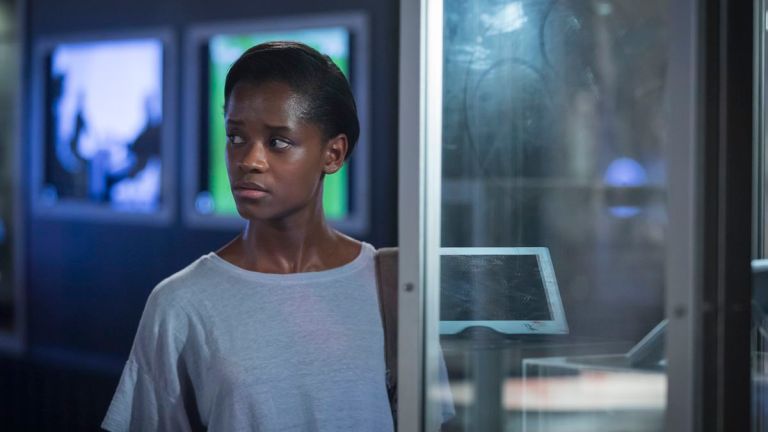Black Mirror season 4: Black Museum review
Season 4 ends with a Black Mirror anthology, featuring three nasty stories and Easter Eggs aplenty. Spoilers ahead…

This review contains spoilers.
4.6 Black Museum
“This place aint for the faint-hearted,” warns Rolo Haynes, conscienceless exploiter of other people’s misfortunes and curator of the Black Museum. “I think I can handle it” laughs young tourist Nish.
Oh, she can handle it.
This neatly woven anthology of three mini-stories is anchored by two excellent performances. The first is from British actor Letitia Wright, who’s soon to be seen in Marvel’s Black Panther, the second from the hugely charismatic Douglas Hodge (also British) as Haynes, emcee of this horror show.
The titular Black Museum is a warehouse in the desert outside Las Vegas (actually the Tabernas Desert in Spain, standing in for the Mojave). Curated by Haynes, it houses a collection of macabre artefacts used in crimes throughout the decades, several of which originate in Black Mirror. The many, many Easter Eggs will be picked apart in time, but a quick glance spots references to season two’s White Bear and Be Right Back, season three’s San Junipero and Hated In The Nation and several episodes of season four (which won’t be spoiled here in case anyone is doing as Brooker says is entirely possible here and watching the episodes out of Netflix’s order – this is intended as the finale).
As ‘Nish’, Wright is casual, sparky and kind – easily the most likeable character we meet in the episode. When the big twist reveals that she’s not the fly in Haynes’ web but the spider, Wright transforms in front of us. It’s a great twist and a satisfying one too. Black Museum ends with justice done and amoral creep Haynes paying the price for ruining people’s lives in pursuit of filthy lucre. Murder, torture and arson aside, it’s a happy, optimistic ending to a dark episode themed around the ravenous pleasure taken in other people’s suffering.
The first tale, about sadistic Dr Dawson is the most physically horrid, while the second has a wickedly cruel and absurd sense of humour that makes absolute sense coming from the mind of Charlie Brooker (incidentally, if Netflix is considering releasing a line of talking plush monkeys as merch, put me down for two). The third sad story has no laughs and functions to sober us all up and remind us that people are monstrous and also, we might just be monsters for watching that monstrosity as entertainment.
Dr Dawson’s story is based on an idea brought to Brooker by Penn Jillette (of Penn and Teller fame). Over thirty years ago, Jillette conceived a short story called ‘The Pain Addict’ about a sci-fi gizmo that enabled physical sensation to be transferred from one person to another, and a doctor who became sadistically addicted to other people’s pain. The story was judged too dark by his publishers at the time, and it’s taken until now for Black Mirror to give it a home.
It’s hard to imagine a more fitting one. ‘Dawson’s Symphatic Diagnoser’ feels both very Black Mirror and entirely in keeping with Rolo Haynes’ retro carney vibe. Hodges’ character is in the classic ‘sinister storyteller’ mode. He could have walked straight in from Creepshow or Tales From The Darkside. When Haynes complained of it being “hot as hell in here”, I lost all sight of Black Mirror’s sci-fi remit and assumed he was the devil. Of course, he is the devil really, a conscienceless, sleazy corporate man whose voiceovers are full of cheap gags and callous sentiment. “If it did something bad, chances are it’s in here,” he tells Nish. Well he did, and he is, though not for much longer.
Each episode of season four has felt visually distinctive and this is no different. The mountainous desert landscape could make it a negative pair of Crocodile, with its expansive Icelandic vistas, but in tone and texture, it stands apart even from that.
One thing that links it to the rest of the season is the use of music as a punch-line. In Arkangel there was Mother, in Hang The DJ, Panic, the Smiths song from which those lyrics were taken, and here, the story opens and closes with Sandie Shaw’s (There’s) Always Something There To Remind Me, a neat joke at the idea of the digital consciousness transfer. It’s a terrific choice, because like all those big sixties pop songs, the melody is peppy but the words are devastating. “I will never be free. You’ll always be a part of me.”
Thematically, this is the most cynical episode of the season, holding up a—yes—black mirror to some ugly human truths. Even though Wright’s character took her revenge, the final feeling isn’t happiness, it’s uneasiness.
After that collection of surprising, unsettling stories, Black Mirror, Monkey loves you, but Monkey needs a hug.
